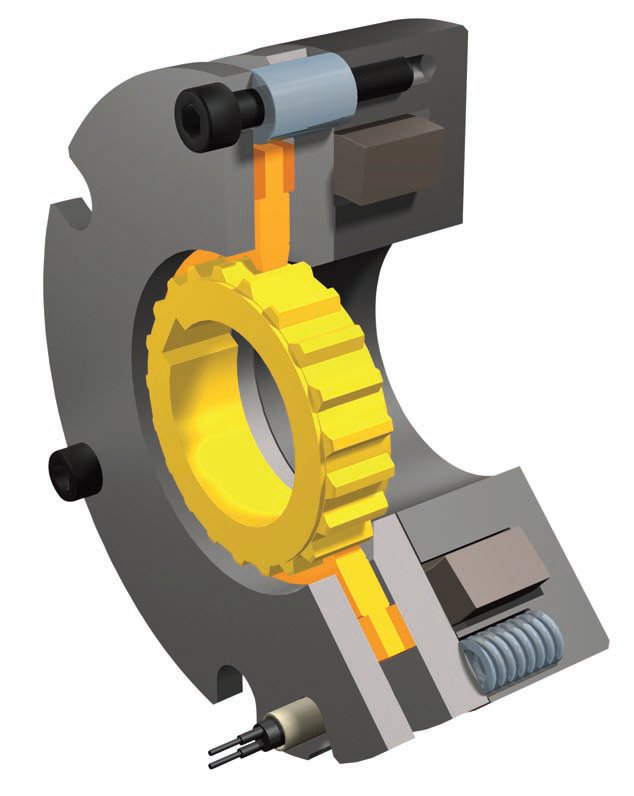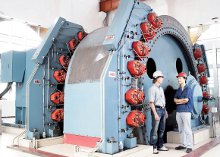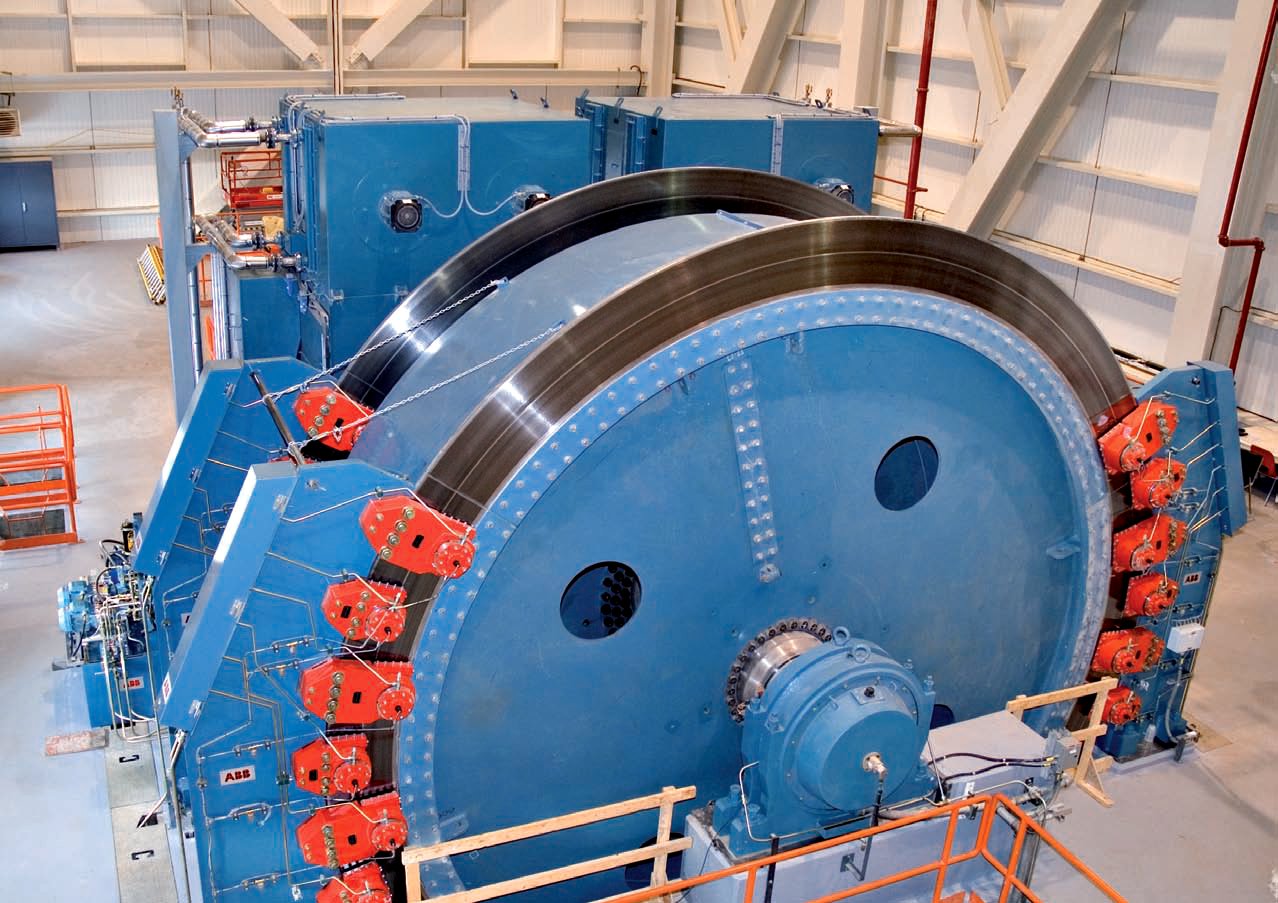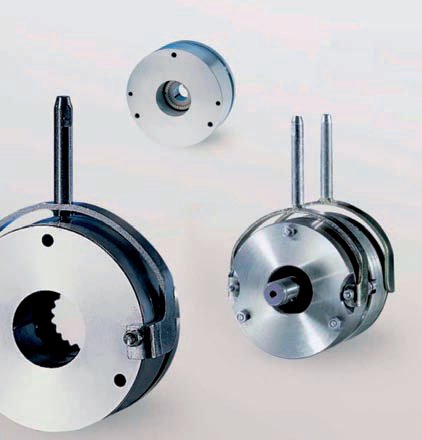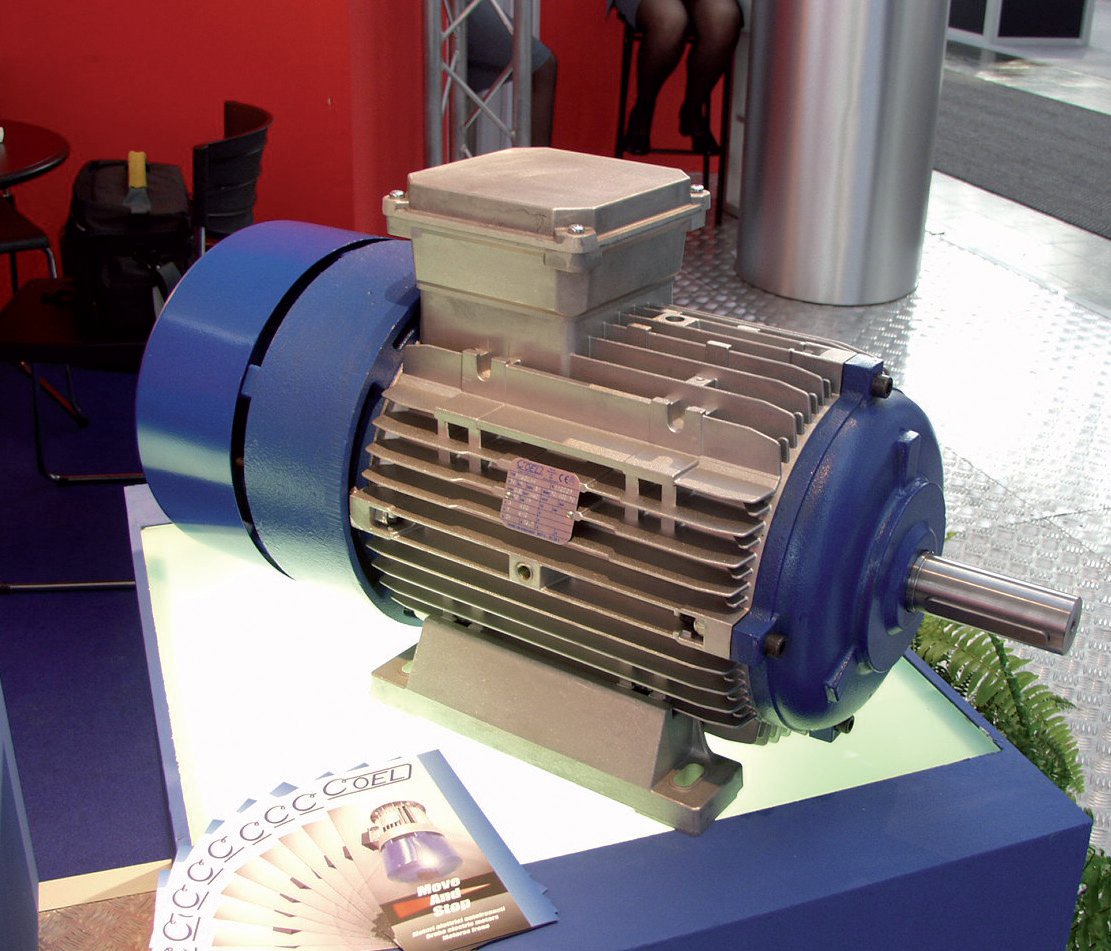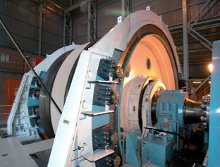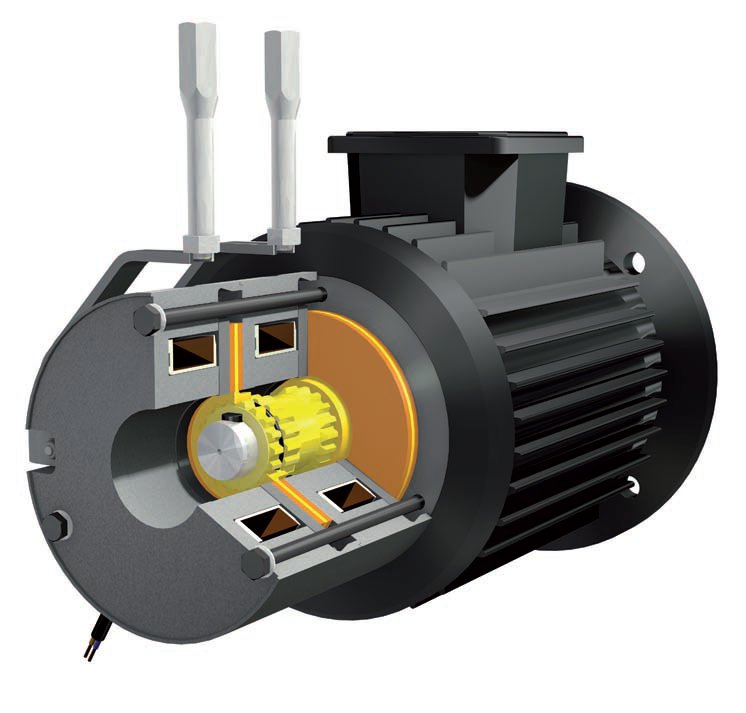Evolution or revolution?
12 June 2014The increased use of electronic monitoring for operational safety and maintenance is just one trend in brakes.
At the same time, complex digital control and monitoring systems are developing apace, and the use of sophisticated finite element design analysis and multi-dimensional computer design tools is now standard for the big manufacturers.
"But some industries can be quite conservative in how they take up technology" says John Miller, an engineer at the British Elevanja manufacturer, now part of the Canadian Johnson group. His division still makes a range of large scale drum brakes, thruster and magnetically operated. He says about 50% of the output from the firm is for external shoe drum systems.
Old fashioned?
Paradoxically the industries taking the units are anything but old fashioned and include the nuclear handling sector and the defence industry he says. All the more reason perhaps to stay with the tried and tested when the loads being carried are extremely sensitive.
"Also the brakes often fit into existing installations - sometimes we are doing renovations. I think it also helps with access for ease of maintenance perhaps," he says.
One particular application underway, is for a crane inside the enclosure "coffin" being constructed around the damaged Chernobyl nuclear reactor to contain the radioactive wreckage.
Elevanja also produces a range of heavy-duty disc brakes, both air and hydraulically operated, manufacturing both the calliper brakes themselves and also a comprehensive selection of discs. The Johnson factories in Canada additionally make a wide range of disc brakes and electromagnetic brakes installed around the world.
Conservative approach
At German maker Pintsch Bubenzer, a major brake supplier for the hoist and crane sector among others, sales engineer Dirk Schlamaus, says that some parts of heavy industry, particularly in the US, also remain quite conservative. "That is particularly true for industries handling very heavy loads, especially in steel works and other metal handling industries where they can be carrying several hundred tonnes of molten metal."
One reason for the choice is that drum brakes have paired shoes that operate from both sides of the axle and therefore throw less asymmetric stresses into systems he thinks. "Though nowadays gearboxes and motors are stiff enough to cope in the main."
Bubenzer includes a number of drum brakes among its substantial range of brakes, though Schlamaus says that they are not being actively developed further. Attention is on its calliper disc brakes ranges. The company was among the first to introduce disc brakes in the 1960s.
Ranges include the SFB type for travelling, trolley and hoisting gear in crane construction as well as in roller mills, smelters and offshore installations. A seawater-proof version is used for winch motors in shipbuilding and as a safety holding brake for wharf crane installations. The series has torques from 63 to 10000Nm.
The KFB range of electromagnetic brakes, developed in recent years, is a dynamic brake with braking torque of 100 to 1600Nm and is chiefly for internally and externally cooled motors on travelling, trolley and hoisting gear. It has a particularly compact design he says and a high protection class making it suitable for seawater and/or tropical environments.
Global presence
Bubenzer has a worldwide presence with some 490 subsidiaries in various countries; major markets now extend to China, the Americas and Europe. Saudi is significant. "Our range does include smaller units but the mass producers have much of that: we tend to concentrate on the larger end of the market."
Developments include the exploration of better friction materials capable of handling higher temperatures, and increasing use of detectors systems to allow wear levels, operating temperatures and other factors to be monitored.
Schlamaus says that storm brakes for holding wharf and container cranes during storm conditions are part of the firm's output; a recent new launch in this market has been a "green" brake operating entirely electrically without any hydraulics. "That means accidental spillage of hydraulic fluid can be ruled out which is important in marine environments."
Another major supplier in Germany is Intorq, situated near Hanover. It has factories also in Shanghai and in Atlanta in the US.
Originally part of materials handling and automation systems company Lenze, the firm became a stand alone brake company after a management buyout in the 1990s; Lenze still uses and also sells on the brakes though they go also to a variety of other manufacturers. A standard brake motor is part of its output.
"One of the major products is the BFK458 which is a modular system; you can fit it with various features and configure it for a wide variety of uses. There are heavy duty armature plates you can choose, or noise reduction for the splines, fixed or adjustable torque, special protection rings" sales engineer Armin Seemann explained to Hoist.
The brakes come in nine different sizes from 6 to 25 and with torques from 1.5 to 600Nm he said. "And you can have it fitted with detectors and microswitches for various maintenance and function monitoring purposes."
The unit has a preset air gap and manual release facilities for all sizes.
"The brake can also be used piggyback in a double configuration for safety redundancy," he says.
Modular range
The company has recently launched a new modular range, BFK 470. "It has similar features but high protection against air dust and water. It is a sealed unit with IP66 protection," says Seemann.
The unit can also be ordered in a cold climate version (CCV) in which case it is usable down to temperatures of -40degrees C. The main target for this new model is the wind turbine industry and so for the moment the size range is kept at 14, 16 and 18.
"We did have a previous sealed unit, the BFK461, but this is more compact and has a hand release system which the other did not."
Intorq brakes are mostly spring applied rather than using a permanent magnet design and this type of unit is becoming more prevalent.
Another German maker Mayr, has switched over to this kind of design more and more says marketing manger Helmut Kleinheinz. The company which prides itself on its research and quality control, makes a wide range of brake types in its Roba ranges including the Roba diskstop safety brake for brake discs; the Roba-stop Silenzia, an specially quietly operating design aimed at theatrical and stage use; and the Roba-duplostop, which is a double action brake aimed at the elevator market. A basic unit the Roba-stop-M motor brake comes in two versions, standard and as a holding brake.
Industry trends
The latter reflects one of the ongoing trends in the industry, which is that basic braking function is increasingly done by frequency inverter motor drives and the task of a brake is simply to hold the load in the static condition. But even for this "parking" function every brake must have the capacity to quickly stop movement on its own in the event of a motor failure or other emergency.
A new range launched last year is the spring applied "ROBA-servostop" safety brake, which uses a spring system to apply the brake, and an electro magnetic release mechanism. That means a "fail-safe" operation applying the brake automatically in the event of power failure.
"Normally, servomotors are fitted with permanent magnet brakes" says Mayr marketing manager Helmut Kleinheinz. These use a powerful magnet to close the brake and an electromagnet to release it.
"But the cost advantage for those is diminishing, because magnetic materials have become extremely expensive."
The spring mechanism is also less vulnerable as permanent magnets can lose magnetic force when subjected to high temperatures, which modern motors can produce. The new design also allows ten times the load-mass ratio says Mayr.
"Normally 3:1 or smaller is selected for servodrives for favourable regulation characteristics and high dynamic loadmass ratios from load to motor. The ROBAservostop permits load-mass ratios of 30."
Brake components
Mayr sells to a number of major companies, including Finland's Konecranes, which buys in most of its brake components for its wide range of hoists. Mayr is a main supplier.
"But we do make one brake unit ourselves" says Konecranes chief engineer Jussi Kuikka. "That is a drum brake for the bigger hoists." It is used only for the frame size E that is for minimum capacity of 12.5t and maximum 80t he says.
"We use a drum design here because this is a secondary redundant safety brake for overspend braking, or holding or both functions. It is an optional extra fitting for some customers have special requirements, perhaps those using hoists for molten metal handling for example."
The drum type design is used for reasons of space; there are already commercial bought brakes on the hoist and traveller. "That leaves no room for another except for a drum type," he says.
One sector, which has switched almost entirely to calliper disc brakes, is the underground mining industry. The very large hoists used for deep shafts carry out an extreme task lifting very heavy loads but with strict safety requirements since they carry large groups of workers to the deep mine faces.
Extreme lifting
Their range is extreme, lifting loads over 200m to 800m in the coal industry, up to 1200m in most metal mining and for a few exceptional cases unwinding to depths of 3000m, most famously in the extremely deep gold mines of South Africa.
Such hoists must cope not only with the main load but a very significant weight of the cable itself.
Safety breaking on such hoists is a complex business. Although some old drum-brake hoists still exist, most modern installations use multiple ranks of large calliper brake units, with double and even four "channels" for the hydraulic system.
The brakes usually are applied on disc extensions to ends of the hoist drums, welded or in the latest units more likely bolted to the endplates. These can be of a very large diameter which means torques are high, demanding powerful brake calliper units.
One of the major international suppliers in this field is Swiss-Swedish firm ABB, which has been supplying disc brake assemblies for mines since 1962. Most often these are part of the complete hoist installations which ABB makes, but it makes but also as stand alone brake packages integrated into the control systems on other makes of hoist. A significant part of the work is renovation or upgrading of brakes too; that might involve adding brake disc extensions to older hoists. They are custom designed and bolted on.
"A brake installation comprises the brake stand for the calliper units, the callipers themselves, the hydraulic operating circuits and controls for those" says Oswald Deucher, global product manager for hoisting solutions. He is based in Sweden, which with its very deep iron ores mines, was one of the original markets for the company.
"There are also sensors for the brake air gaps, and finally an overall control system which is either a programmable logic unit or these days a computerised system based on SIL standards."
The air gap measurement is vital says Deuchar as it influences the hydraulic brake unit's clamping force. If the air gap increases, the force will reduce. Additionally it can lower the lifetime of the application springs.
Typical installation
The electronic sensors have a resolution of 0.1 mm, and present the air-gap values to be presented on the hoist operator's screen in the control room.
A typical installation might include several brake stands mounted either side of the drum disc and each with three or four separate calliper units. "These are bought in components from companies like Twiflex" says Deuchar. The company recommends that two discs are used on a hoist, each with separate stands.
The stands carry the hydraulic brake units, piping and valves for a pipe branching system. These are controlled by the overall operating system but manually operated valves are also attached to each brake unit to allow them to be held in the open or closed position for testing or maintenance.
The multiple circuits for the brake channels, the hydraulic system that pushes the springs back on the callipers to release the brakes give considerable redundancy for safety. As with most system the brakes only release under power, and if that fails the springs close to clamp the discs.
Also like most modern systems, the bulk of the braking function is done by the motors themselves with the brake units for parking. But they must also operate in emergency and strict safety standards apply for that.
"These vary from country to country and the designs have to match the particular requirements," says Deuchar.
Except in the case of total failure, the operation of the brakes cannot be simply a sudden application, which would jerk to a halt the descent or ascent. Not only would that be potentially damaging to equipment but it is potentially severely injurious to riders thrown upwards in the cage.
Emergency braking
According to ABB's product information: "In the case of loss of motor power, overspeed, over-travel or any other emergencies, the braking system serves as the ultimate means for safely. But it brings the hoist to a full stop with the retardation rate complying to the specific mine safety regulations. These often stipulate retardation at a minimum 1.2-1.5 m/s2 for a full load in the descending direction and of maximum 5.0 m/s2 in the ascending direction.
"In addition, the braking system must have a static holding capacity of 2-3 times the out-of-balance torque. The number of brake units needed for a particular hoist is normally determined by the static braking torque, since the dynamic braking torque needed for a retardation of 3 stipulated 1.2-1.5 m/s2 for a full descending load is generally lower than for the braking torque at still stand. One exception is mine hoists in very deep shafts. In these cases, due to the large rotating masses of the hoisting system, the number of brake units might instead be determined by the retardation requirements."
Emergency braking is usually applied in steps for a gradual deceleration but ABB says it has developed a system for an essential smooth gradient of increased braking.
"Retardation with constant torque is widely used" it says "in which hydraulic pressure is reduced in two steps to achieve a preset braking torque with limits for specified minimum and maximum retardation rates. But with this method, there can be a large variation in hoist retardation rates compounded by the risk of rope slip. Retardation of a fully loaded ascending conveyance might exceed the permitted safety level.
ABB's system continuously controls the braking torque during emergency stops, to control and reduce retardation to a continuously safe level.
At an emergency stop the oil pressure quickly drops from full pressure to the upper control limit. It is then further reduced following a ramp function in the control system until the required retardation setpoint, is obtained. The actual retardation level is measured by a speed feedback device.
ABB sells worldwide. Big markets include Sweden, Germany, South Africa, the US and increasingly China.
Earlier this year, Italian company Coel Motori highlighted that one growing trend is the use of compact design brake motors, with the company specialising in these with four different series of brakes motors.
First are the F type, which are closed and externally ventilated. The brake groups and all the motor parts are designed and made by Coel. The brake group is supplied on series with AC 3phase electromagnet but a DC version is also available.
The FK motors are DC with rectifier and like the F-type can be driven by inverter though that means a separate power supply for the brake and the motor. These have die pressed aluminium cases and braking surfaces in cast iron.
A final series the SW is made for situations where the motor faces frequent water contact. The brake motors are not ventilated and are totally enclosed. Coel sells substantially to the oil and gas industry and particularly for environments where explosion proofing is needed there is the new modular explosion proof brake the VIS. It has a patented design for hazardous location areas says Coel marketing manager Alessandro Tonon.
"The unit is designed for multiple application fields such as hoisting and travelling applications, winches, capstans, wire rope hoists and chain hoists," he says.
Elsewhere, vice-president of sales for US maker and distributor, the Hilliard Corporation. Juan Parra describes another development in brakes. "In the post-war period the drum brake was most often used, an external shoe type rather than the internal drum brakes you find on a car."
But as the technology developed for disc brakes in cars it also started to be used for industrial applications he says, with one of the first calliper disc types being offered by the British company Twiflex, now part of the Altra Industrial Motion Group. These did not use a drum but a disc attached to a spinning power transmission shaft with clamping callipers applying brake pads.
"There are significant advantages to the disc type" says Parra. The most important is the way the brake can disperse the considerable heat build up that braking friction always produces. "Most drum brakes have one side more accessible than the other and heat passes out on one side unevenly.
Another type of brake, the plate brake, has even bigger problems he says. Plate brakes have a sandwich of several friction plates and braking surfaces, which provides a lot of braking surface in a compact space, which is sometimes useful, but "there is no easy way to dissipate the heat". If the brake is used only occasionally, as on aircraft landing gear for example, where there is time to cool again, that can be overcome.
"But not for frequent use."
New materials
The problem with hear loss through one surface is that a hear gradient is created with causes expansion and other effects on materials he says which in turn can lead to cracking or other problems. New materials are being developed which can help this, but the symmetrical structure of disc brakes allows more even dissipation and greater material stability he says. Another advantage of disc brakes is that they can cope with greater torque.
This has allowed the location of the brake to move over the years from the motor drive shaft to the gearbox output shaft, which turns faster but with higher torque. Disc brakes can also be built to greater sizes he says whereas drums are limited to less than 30" (750mm).
"Another development is to put the brake even further along on the cable drum itself," he says. That requires the drum to have one flange enlarged to act on the outside as the brake disc.
The advantage is that the braking action is further along the connection which offers greater safety if the transmission should break; stopping the motor output is no use if the geartrain has broken.
"Mostly the drums are not being made that way but you can retrofit with welded or bolted extensions" he says.
Drum braking
An extension of the drum braking is the addition of various safety brake systems particularly in elevators and some theatrical stage equipment he says, with brakes fitted on cab roofs and running over a vertical rail, activated by sudden acceleration to clamp on and stop. Systems like that are used too in mines for the explosives wagons running to the face.
Hilliard makes some of its own brakes and particularly in very large sizes, says Perra; one of the biggest is for a moving stage setup at one of the large theatrical stagings in Los Vegas.
These are hydraulically activated rather then using the electro-mechanical methods which open the callipers on most disc brakes. The hydraulic method has greater pressure for pushing open the springs on the very large brakes. Like all these braking systems the callipers have to be opened actively during operations, creating a "fail-safe" condition where they close if the power fails.
"But we also buy a lot of our brakes from Twiflex and are the North American dealership for their products" says Perra. The range of industries covered is large from paper mills to mining and steel mills to shipyards, and other marine applications. Theatre and sport is also a used from scenery hoists in opera to scoreboards in stadiums.
